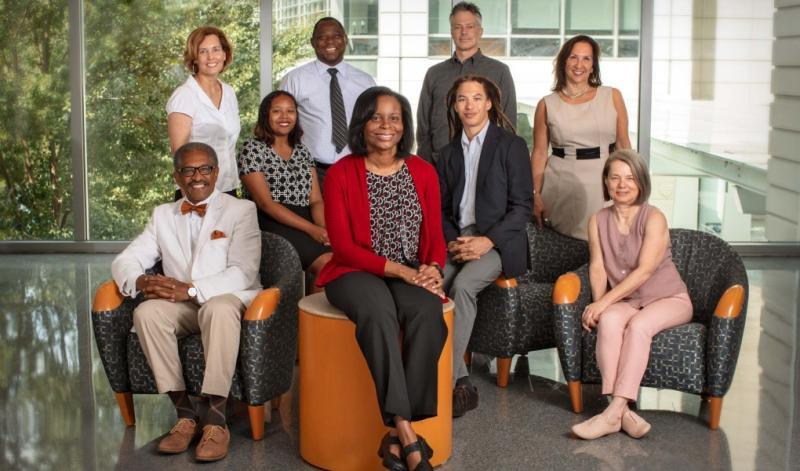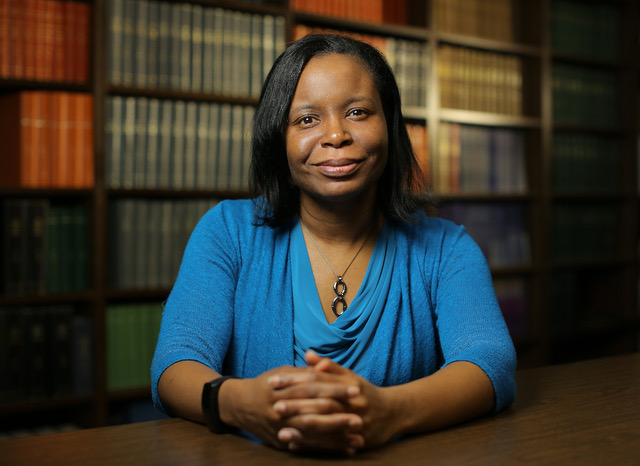
Community has always been central in the life of Kimberly S. Johnson, MD, associate professor of medicine (Geriatrics) and director of the Duke Center for Research to Advance Healthcare Equity—also known as the REACH Equity Center.
Dr. Johnson grew up in tiny Winstonville, Mississippi, just outside Mound Bayou, a town founded by former slaves in 1887. She was aware that barriers to her success existed in the larger world, yet inside her all-black community, surrounded by grandparents, aunts, uncles, and cousins, the sky was the limit.
“Probably more than anything else, I’m a product of my community,” she says.
Her father told her if she studied hard enough she could achieve anything.
Her 7th grade teacher said almost daily: “Be ashamed to die until you’ve made a worthwhile contribution to society.”
Members of Johnson’s church took her to science museums, cheered her on at oratorical competitions, and told her about academic summer enrichment programs—and encouraged her to apply.
Johnson took all this to heart and, as a sixth grader, planned to become a Supreme Court justice. Or perhaps teach school in an impoverished area. “No matter what I was going to do, in some way it was going to involve social justice,” she says.
She settled on medicine after spending a summer during college working at a community health clinic in Mound Bayou. She wanted to return to the clinic as a doctor, to provide healthcare for the underserved population.
Johnson graduated from Dillard University, a historically black university in New Orleans, and headed to Johns Hopkins University for medical school. There, she felt like a minority for the first time in her life. Far from home, she continued to draw sustenance from her childhood community: When she got the lowest score in the class on a test the first year—a highly unusual and therefore deeply disturbing experience—she called a high school friend who put her in touch with her geriatrician aunt for encouragement and counsel.
At Duke—as a resident in medicine and then a geriatrics fellow—Johnson fell in love with teaching and research in addition to caring for patients and their families. In order to work in a large academic medical center where she could combine all three loves—teaching, research and patient care, Johnson knew she wouldn’t be going back to the Mound Bayou community clinic. It also meant her work would have the potential to touch many more lives.
End-of-Life Health Disparities
Encouraged by mentors Harvey Cohen, MD, professor of medicine (Geriatrics) at Duke, and James Tulsky, MD, then at Duke and now the chair of Psychosocial Oncology and Palliative Care at Dana Farber, Johnson dove into research related to health disparities in hospice and palliative care. “People understood a lot about disparities in disease prevention and chronic disease management,” she says, “but there had been little attention to racial and ethic disparities for people with serious illness approaching end of life.”
For example, interventions that improve the quality of care for seriously ill patients—like hospice and advance care planning—are used by ethnic and racial minorities at significantly lower rates.
Johnson uncovered a number of factors among African Americans that contribute to these end-of-life disparities, including religious beliefs, discomfort discussing death, increased desire for aggressive care at end of life, and distrust of the medical system. She showed that it is the combination of these cultural beliefs—not any one of them alone—that added up to African Americans being less likely to pursue hospice or participate in advance care planning. Some of her research has focused on finding ways to increase the use of hospice, palliative care, and advance care planning among African Americans through education, partnerships with faith communities, and increasing the percentage of African Americans hospice workers.
Back in 2007, Johnson presented the results of her research at the Department of Medicine Grand Rounds. One of the attendees, Laura Svetkey, MD, MHS, professor of medicine (Nephrology), remembers the presentation vividly to this day. What struck Svetkey was how Johnson illustrated her points with examples from actual families facing end-of-life issues.
“It was very patient-centered and personal, and at the same time, incredibly rigorous scientifically,” Svetkey says. “That’s the thing she does better than almost anybody I’ve seen is to combine the human aspects of medicine with scientific rigor.”
Birth of the REACH Equity Center
In 2015, Svetkey, Johnson, and a number of other investigators started working together on issues relating to health disparities and implicit bias, and in 2017 they applied for a Centers of Excellence grant from the National Institute on Minority Health and Health Disparities (NIMHD).
Duke’s application was funded, and the REACH Equity Center was born, with Johnson as the director.
And with that, Johnson began building a community at Duke for addressing health disparities. Many investigators across campus were already working on these issues but often in isolation. Svetkey, who is associate director of the center, says, “Before REACH Equity, we had all this strength [in disparities research], but we didn’t know about each other and we had no home.”
Also in 2017, Johnson landed a $5.8 million grant from the Patient-Centered Outcomes Research Institute (PCORI) to study two different types of advance care planning interventions in a multi-site study of 800 patients, half of them African American, in the Deep South. The study is currently enrolling patients not only at Duke but also at medical centers in South Carolina, Georgia, Alabama, and Texas.
The REACH Community
Today, faculty, students, research staff, program coordinators, and other interested parties from Duke’s Medical School, School of Nursing, and the university have come together under the umbrella of the REACH Equity Center.
REACH offers funding, training, and peer-support for investigators at all stages of their career, from medical students to senior researchers. Many of these projects are partially funded by the Offices of Dean Mary Klotman, MD, of the School of Medicine and Chancellor Eugene Washington, MD, as well as the Center. “That speaks to their belief about the importance of addressing health equity and the work we’re doing,” Johnson says.
REACH is not just about funding; it’s also about collaboration and community. Twice a month, REACH community members gather for Research Works in Progress (RWIP) seminars, which Johnson says are open to all. “If people want to become engaged in REACH,” she says, “RWIP is a wonderful place to start.”
Sarahn Wheeler, MD, assistant professor of obstetrics and gynecology, received a Career Development Award from REACH to study ways of reducing pre-term birth rates among black women, which are 49% higher than in other racial and ethnic groups. She first identified factors that help explain why a low percentage of black women receive progesterone injections that have been shown to reduce pre-term birth. These factors included inconsistent instructions from the clinic, difficulty getting to the clinic for shots, and lack of peer support and encouragement. Next, she worked with patients, nurses, and clinic staff to design an intervention that she plans to pilot soon.
Wheeler values the input of the multi-disciplinary REACH community. “Most often when I present my work, it’s to people who are very knowledgeable from the obstetrics standpoint, but not people who are experts in disparities research,” she says. “So it’s very helpful to have [colleagues who] understand that aspect of the work and can rigorously appraise the methodology.”
In the enormous field of disparities in health and healthcare, the focus of the REACH Equity Center is on the clinical encounter.
“There’s a significant amount of evidence that even patients who have the same socioeconomic status and access to care still have different outcomes depending on race,” Johnson says. “That has something to do with the clinical encounter.”
“There’s a significant amount of evidence that even patients who have the same socioeconomic status and access to care still have different outcomes depending on race,” Johnson says. “That has something to do with the clinical encounter.”
REACH also focuses on interventions rather than simply documenting disparities and their causes. Three interventions are being evaluated in projects that were funded as part of the Center of Excellence grant: implicit bias training, communication coaching, and a mobile app to aid communication between families and providers in the intensive care unit.
Clinical encounters can’t exist without patients, so the REACH Equity Center actively solicits patient and family input. Major Cynthia Kornegay, who works for the Durham County Sheriff’s Office in the Detention Services Division, helps provide that perspective as a member of the Stakeholder Advisory Board. At first, Kornegay says she wondered what she could possibly contribute since she had no medical background. “I soon realized that in some ways my voice was one of the most important there, because I didn’t have that background,” she says. “I give them my perspective from being a patient or daughter or mother. They have really made us feel that they cannot do the work they do without us.”

Past and Future Ties that Bind
In March 2020, Johnson’s body of work will be recognized with the first Richard Payne Outstanding Achievement in Diversity, Equity and Inclusion Award, given by the American Academy of Hospice and Palliative Medicine. The award is named in memory of Richard Payne, MD, who was a professor emeritus of both medicine and religion at Duke before he passed away in January 2019. Johnson and Payne published several papers together about hospice disparities. They were not only colleagues, but also friends.
“It’s hard to even talk about,” she says. “I am extremely, extremely honored, but I know the award exists because he’s no longer with us. It’s not only a loss to me and my family, but to the field. No one was more passionate about issues related to improving end-of-life care for African Americans.”
When Johnson looks to her past, she sees her beloved childhood community in rural Mississippi, where relatives and friends supported and nurtured her. Yet that community didn’t have full access to all that modern healthcare has to offer.
When Johnson looks to the future, she sees the REACH Equity Center disseminating solid evidence-based interventions, and continuing to raise awareness about health disparities, particularly in relation to quality of care. “It’s pretty hard to have one without the other,” she says.
Most of all, she hopes the REACH Equity Center will help improve healthcare for African Americans and other ethnic minorities not just at Duke, but in communities all across the country—communities like Winstonville and Mound Bayou.
This story was written by Mary-Russell Roberson, a freelance writer in Durham. She covers the geriatrics and aging beat for the Department of Medicine in the Duke University School of Medicine. Feature photo by Bruce DeBoer. This story first appeared on SOM Magnify.